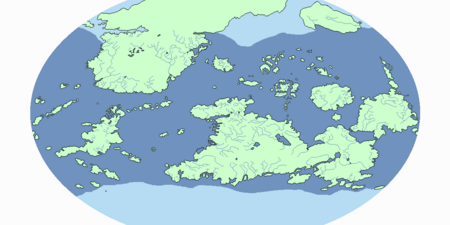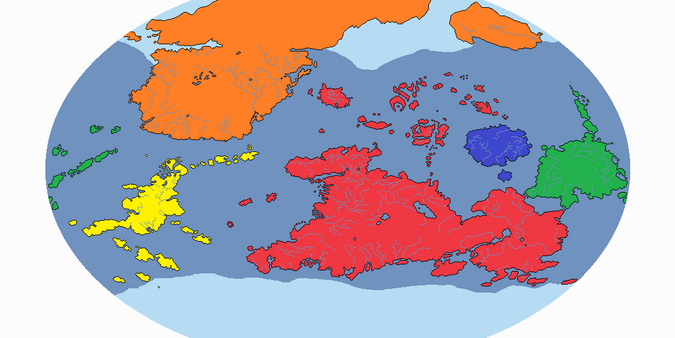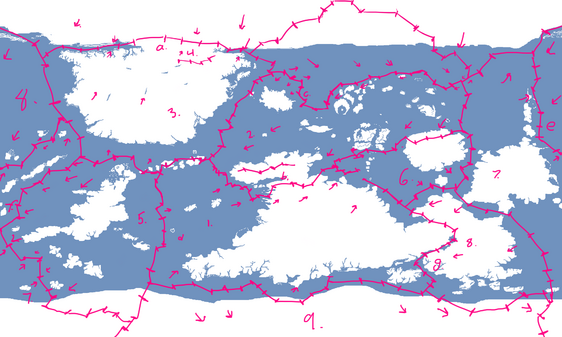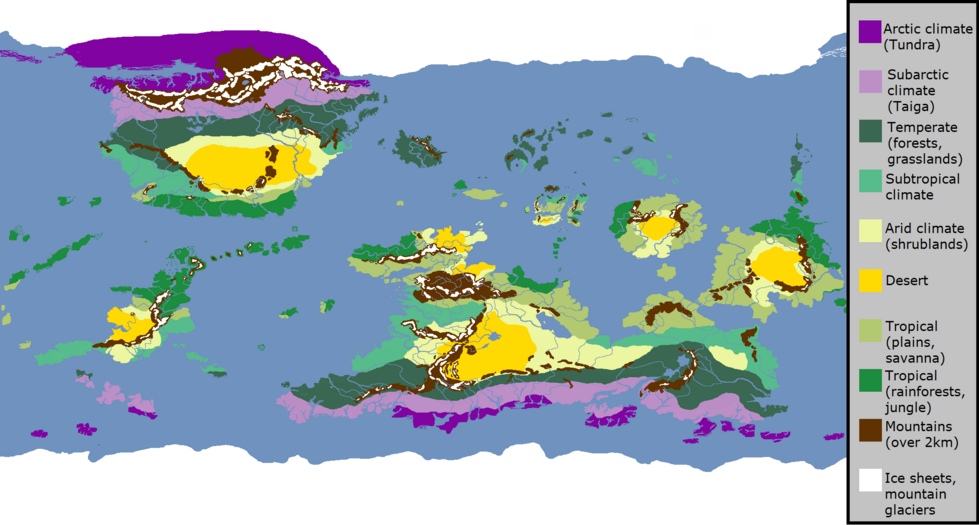Amanir
 Continents of Amanir | |
| Orbital characteristics | |
|---|---|
| 149598023 km[1] | |
| Eccentricity | 0.0167086 |
| ~365.3 days | |
| Physical characteristics | |
Mean radius | 6371.0 km[2] |
| 510072000 km2[3] | |
| Mass | 5.972 × 10^24 kg |
| 9.81 m/s2 | |
| 40270 km/h[4] | |
| Albedo | 0.367 geometric |
| Atmosphere | |
Surface pressure | 101.325 kPa |
Amanir, sometimes reffered to as simply the world — conworld[5] of the members of the Federation of Allies, a NationStates region. Lorewise, Amanir is a planet located in an unspecified star system and galaxy, possessing extrimely Earth-like qualities, including mass, gravity, size and atmosphere nearly identical to that of Earth, as well as one major moon. Amanir has wide oceans and numerous archipelagos, as well as several major continents. In contrast to Earth however, most of Amanir's landmasses are located on the southern hemisphere.
Amanir as a project combines both a priori and a posteriori elements, meaning that it is a site of both real-life languages or scripts on one side and conlangs[6], as well as constructed religions and scripts, on the other. There is no fantasy races like elves or dwarves however, unless they are purely mythological and appear in beliefs of human nations. Status of magic is as of yet unclear, with some within the region proposing a limited existence of magic and others opposing it all togather.
One of the characteristical features of Amanir is the existence of megafauna and many other relatively recently extinct species.
Name
Etymology
The name Amanir comes from Aydinirian word Amanir [ama'ɲir] and ultimately from Old Aydinirian Amanıer [ama'nʲɛr], meaning "beautiful land". It has deep connections with Jarist cosmogony, as it was supposed to be a descriptive name given by the First Cause to the world upon its creation. In Modern Aydinirian amanir as "world" is often used in poetry.
The planet has also many other names in different languages spoken at its surface.
Names in other languages
| Language | Name |
|---|---|
| Old Aydinirian | Amanıer, Hwéstar /ama'nʲɛr/, /xʷes'tar/ |
| Aydinirian | Awestar, Amanir, Firyaxar[7] /awɛs'tar/, /ama'ɲir/, /firja'ksar/ |
| Saruzh | илнаму [8] ilnāmu /ilna:mu/ |
| Üxa | mülimax /mylimɐx/ |
| Reikish | Weoertha[9] |
| Haida | Hlan'gwáay[10] |
| Volgan | Myra Oyat [11] |
World
The planet of Amanir is located in the so-called Goldilocks Zone, which makes Earth-like life possible and prevalent. Length of day and year is also extremely similar to that of Earth, planet possesses also a strong magnetosphere. Volcanism is a strong force on Amanir, responsible for creating many volcanic archipelagos and mountain ranges. One of the reasons for that is strong interaction between the tectonic plates and faults.
Geography
The surface of Amanir can be divided into multiple different geographic, historical or cultural regions. The popular and often used method is dividing the planet into five primary continents, with most borders between them formed by oceans and seas. Those continents are: Achara, Gwaii, Ainadestra, Nordenwald and Triuh.
Each of those continents has also other distinct regions. East from the mainland Gwaii lies a big island, called Kilaavik, which is however nearly entirely covered in glaciers. Ainadestra's eastern-most part forms the volcanic Antaran Archipelago. South of Nordenwald lies the island of Faniviace. Imatsshām, a major collection of archipelagos, forms a distinct part of Triuh. Among all of them, the most diverse however is Achara. First of all, two subcontinents are attatched via land to the main body of Achara, Solland in the east and Aydinirian Subcontinent in the north-west. Aydinirian Subcontinent is located mostly on its own tectonic plate, which extends further north, containing many of the northern archipelagos and island chains, including Kïirye, Carinian Archipelago, Grenham Isles and the Twelve Isles. Mainland Achara is often treated as a single continent partly for cultural reasons. Each of those sub-regions is often divided further.
Five major continents of Amanir, although each of them consists also of other smaller regions and subcontinents.
Red: Achara, orange: Gwaii, yellow: Ainadestra, blue: Nordenwald, green: Triuh.
Climate
Large swaths of temperate climate forests and grasslands exist on Amanir, mostly on central-northern Gwaii and southern Achara, but there are also areas where ice bounds enormous territories, mostly in Gwaii and Kilaavik, but also in some southern-most parts of Achara and Ainadestra. Deserts form in the interiors of all continents, but also in other places, like eastern parts of the Aydinirian Subcontinent or southern islands of the Carinian Archipelago. The greatest deserts can be found on Achara and Gwaii and that's where the highest temperatures of the planet can be observed. Other parts of the world enjoy mostly tropical or subtropical climate, eased further by close distance to the ocean.
Several inland seas and major lakes can be found on Achara. Some of them are a result of high tectonic activity on the border between Achara Proper and Solland, others however are the remains of ancient oceans, like the Jalumyyrian Sea, located at the borders of Norcourt.
Some parts of Amanir are extremely mountainous, which allows the formation of mountain glaciers even in equatorial or near-equatorial areas. The highest mountain chains are located mostly on Achara, Ainadestra and Gwaii.
Fauna and flora
Reikish Draughts or Reikish Drafts are a breed of exceptionally large draught horses brought with the Reikish during the Return. Bred initially to pull supply wagons and carry heavy cavalrymen, Reikish draughts are the largest breed of horse in the world. Stallions stand between 20 and 22 hands (203.2 to 223.52 centimeters) at the shoulders and can weigh as much as 1,600 kilograms. Geldings and Mares are slightly smaller but are still considerably larger than a typical horse, as bred in Achara, Triuh, or Gwaii. Reikish draughts became notable for their use in the Reikish cavalry. Wearing a padded blanket for comfort and clad in chainmail from head to hindquarters, the Reikish draught could be devastating on the charge. Trained war horses could reach 40 kilometers an hour, resulting in kinetic energy equal to a car hitting a wall at 30 miles an hour. Few armies could stand up to a charge of Reikish knights and fewer still could hope to repel one. Reikish draughts remain an important part of Reikish culture to the present day, being used for equestrian activity, military ceremonies, and even for commercial ventures.
Volgan Artaal are a genus of large armored bovids that roam Northwestern Gwaii, notably within Volgan territory. They are some of the largest bovids in the world, bearing great resemblance to Altai argali and bighorn sheep with large curved horns built for ramming. Volgan artaals are divided into 3 extant species, the Steppe Artaal, the Mountain Artaal and the Cliffside Artaal. Steppe Artaals are the largest of the artaal species, with the rams standing around 213 cm tall at the shoulders and weighing around 1 to 1.2 tons. Mountain Artaals are considerably smaller, but still quite large artaals at around 170 cm at the shoulders and weigh 750 kg on average. Cliffside Artaal are the smallest and lightest of the artaal by a large margin, barely weighing 190 kg. Volgan artaal, particularly Steppe artaal, were notably used as a major part of Volgan heavy assault and shock cavalry. Charging Steppe artaal could reach up to 55 kilometers an hour, 50-45 with a rider on top, delivering well over their body weight's equivalent force when ramming an opponent head-on, more than enough force to instantly kill a human, and enough to badly daze or even cripple heavily-armored foes like other artaal. Today, Volgan artaal are regarded as a national animal, being used as domestic mounts, and can be seen roaming the wild countryside as their ancestors had done thousands of years ago.
Sherechian Ram locally known as "Rad" or "Atkudo" is a species that branched of from the suborder of Hyppomorpha long ago. They are distant relatives of horses and have somewhat horse like bodies and hooves. They however have shorter necks, thicker legs, more bone mass and have 2 horns similar in shape to male sheep. Other characteristics like hight and fur thickness depend on climate and topography but they can range from 150-220cm of height from the ground to their shoulders. They are used as an alternative to horses as they hold their ground better and can survive hits and attacks better. Their downside is that they are a bit slower than horses (55km/h top speed), their hot tempered character and their highly uncomfortable gaits. Generally used for daily transport and are much more versatile in combat than horses, their advantage over horses is particularly seen in the front line and in mountaineous terrain. Rams are still used in the modern age due to their hardiness (cheap maintenance costs) and being both as vehicle and a pet.
Calendar
So called Standard Calendar counts years with Jashor, meaning the Fall of [Old] Aydinirian Empire, as the point of reference. Year of the destruction of the city of Djyazhoar, empire's capital, marks year 1 AD (After Destruction), alternatively 1 AJ or 1 AC (After Jashor or After Collapse). Events and years that occured before the destruction of Djyazhoar are reffered to as BD (Before Destruction), alternatively BJ or BC (Before Jashor or Before Collapse).
Other methods of counting years are or were also in use throught Amanir. Some of them include:
- Old Aydinirian Calendar, known sometimes also as the Imperial Calendar, was the main Aydinirian calendar before Jashor. History and mythical history was separated into 4 eras or ages, with the Fourth Age being the current one. Years were counted from the traditionally acknowledged date of the Great Exile. According to the Imperial Calendar, Djyazhoar was destroyed in the year 2497 of the Fourth Age. It is sometimes still used for religious liturgy even in the modern day, with years of the Fourth Age counted forward.
- New Aydinirian Calendar evolved from the Old Aydinirian Calendar and forms the base for the Standard Calendar. Just like the Imperial Calendar it categorizes both history and mythical history into eras, but adds another, Fifth Age, which is the current one. It starts with Jashor, in the year of the destruction of Djyazhoar, so year 1 of the Fifth Age. Years are counted forward from that event.
- Reikish Lunisolar Calendar is an ancient calendar, with the first references to it being found in stone tablets dating to the 27th Century Before Destruction. As a lunisolar calendar, it provides both the position of the sun and the phase of the Moon on each day. The difference in length between a Lunar Year of 354 days and a Tropical Year of 365 days necessitated some method of correcting for the drift. This led to a 19 year cycle, which entered use around the 6th Century BD. This was followed in the 800s BD by a 76 year cycle, which was more accurate. However, Reikish astronomers would determine that the 76 year cycle was not accurate enough and would develop a new, longer cycle. Initially, this cycle was around 304 years long, proposed shortly after the 76 year cycle. But, by the early Reikish Kingdom in 183 BD, a new cycle had been adopted with added one days to the year every 228 years. This lasted until the early Commonwealth Period in 1166 AD, when a new cycle added two days ever 437 years. With a mere six minute loss every year, an extra day is required every 240 cycles or 104,880 years. The Reikish calendar marks the end of the Reikish Return in 1055 BD as Year 1 After Return, with all years before that dated as Before Return. As an example, the formation of the Reikish Kingdom in 872 AR took would be written as 183 BD while the start of the Commonwealth Period, dated as 2195 AR, would be written as 1140 AD.
- Gregorian Calendar is the out of universe calendar used as a reference point for in universe dates and key events. The Standard Calendar of Amanir finds Year 1 AD as being analogous to the Year 500 CE by the Gregorian Calendar. The inclusion of this calendar is to provide an easy reference to allow observers to determine when events are taking place by using a familiar frame of reference.
Nations
Demographics
Evolution of humanity
Possible theories
Races and migrations
Languages
Religions
References
- ↑ 92955902 mi.
- ↑ 3958.8 mi.
- ↑ 196940000 sq mi.
- ↑ 25020 mph.
- ↑ Meaning constructed world.
- ↑ Meaning: constructed languages.
- ↑ Meaning "Under the Sun", also used mostly in poetry.
- ↑ lit."All-Ground"
- ↑ Translating literally to "Land of Man's Existence" but most commonly translated as "World of Men".
- ↑ Translates to "the World" or "the Earth" in modern Haida. Small variations between translations in different dialects.
- ↑ Translates to "World of the Awake" in modern Volgan; translations vary in different ethnic languages.



